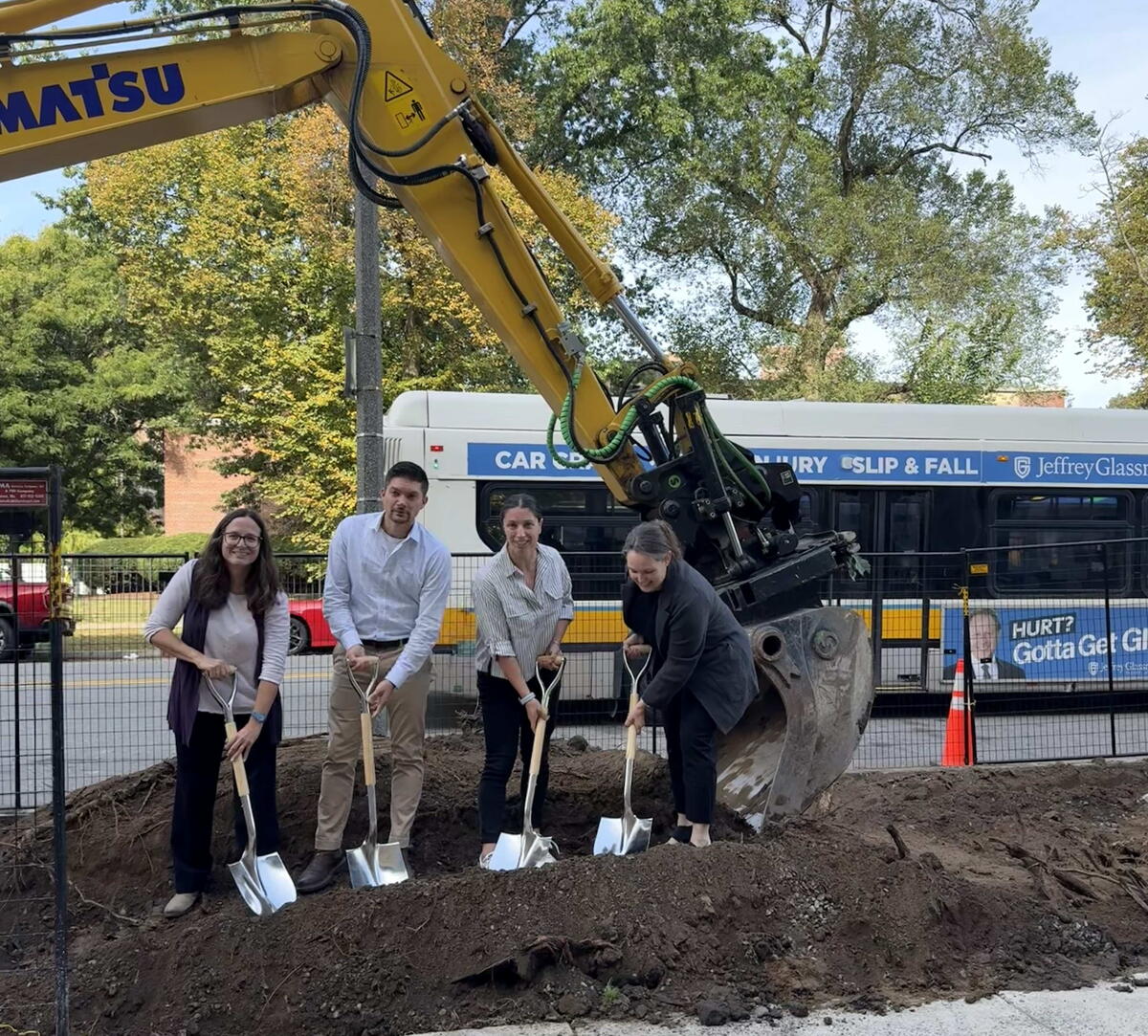LONGWOOD COLLECTIVE JOINS PARTNERS TO BREAK GROUND ON GREEN INFRASTRUCTURE PILOT PROJECT
Longwood Collective Joins Partners to Break Ground on Green Infrastructure Pilot Project
Browne Fund grant supports first-of-its-kind bioswale installation in the LMA on Avenue Louis Pasteur

From left to right: Anna Aguilera, Professor of Biology at Simmons University; Peter Salvatore, Deputy Chief Engineer at Boston Water and Sewer Commission; Abby Oliveira, Senior Land Use and Sustainability Manager at Longwood Collective; and Sarah Rodrigo, Trust Program Manager at the City of Boston
BOSTON – Tuesday, September 30, 2025 — The Longwood Collective, the chief planner and principal steward of the Longwood Medical and Academic Area (LMA), today broke ground on a green infrastructure initiative: a bioswale pilot project on Avenue Louis Pasteur.
This three-year initiative, supported by the City of Boston’s Edward Ingersoll Browne Fund, will harvest rainwater, promote resilient vegetation, reduce polluted runoff, and replace four aging trees at the end of their lifecycle. The bioswale will serve as both a functional stormwater management system and a living demonstration of how sustainable infrastructure can transform an urban streetscape.
“Longwood has always been a place where world-class ideas take root and shape the future,” said David Sweeney, President and CEO of the Longwood Collective. “With this project, we’re bringing that same spirit of innovation to sustainability. Our work here demonstrates how partnerships, planning, and a shared commitment to the environment can make Longwood—and Boston—a healthier, more vibrant place for everyone.”


Aerial future rendering of the bioswale project site
The bioswale pilot project is the product of years of collaborative planning with partners including the City of Boston, Boston Water and Sewer Commission, Simmons University, Charles River Watershed Association, Northeastern University, and Longwood Collective. Together, these organizations have guided the design, approvals, and future monitoring that will ensure the project’s success and provide lessons for future green infrastructure installations across Boston.
“This project reflects Longwood Collective’s commitment to sustainability, innovation, and collaboration,” said Abby Oliveira, Senior Land Use and Sustainability Manager at Longwood Collective. “By introducing green infrastructure into one of Boston’s busiest districts, we’re not only improving the health of our ecosystem but also advancing a broader agenda to create a greener, more resilient Longwood.”
“On behalf of the Edward Ingersoll Browne Fund, we're proud to support this green infrastructure pilot project that will set a new precedent for functional street beautifications,” Sarah Rodrigo, Trust Program Manager at the City of Boston said at the event. “I also want to acknowledge that our funding for the aesthetic components is just one small piece of this effort. The time, dedication, and determination of the Longwood Collective and project partners like Simmons, Boston Water and Sewer really made today possible. Congratulations on this groundbreaking, and I look forward to the positive impact of this project on the Longwood neighborhood and the City of Boston for years to come.”
“We're always looking for opportunities to collaborate on projects that can achieve a mutual goal,” Peter Salvatore, Deputy Chief Engineer at Boston Water and Sewer Commission said at the event. “In this particular case, Boston Water and Sewer gets to share the benefits of the water retention and treatment, and the community gets to enjoy the surface feature for drainage, which is sometimes unusual in the city. We look forward to seeing the project complete and the results of Simmons testing for water quality.”
Students from Simmons University, Northeastern University, and stormwater experts at the Charles River Watershed Association will conduct regular soil, plant, and water quality and volume testing to understand the effectiveness of the system and inform future local planning for similar green infrastructure projects across Longwood.
“This is very exciting -- my students and I will be monitoring the health of the new installations: plant health, soil health, and comparing that to the existing green space on the street,” Anna Aguilera, Professor of Biology, Simmons University said at the event. “I've had students help already with establishing the methods, taking some pre-treatment baseline data, soil samples, and I have student involvement for the long-term so they can get a long-term data sets to quantify the ecological benefits of this really exciting project.”
The installation builds on Avenue Louis Pasteur’s historic role as a gateway to the Emerald Necklace park system. Designed in the early 1900s with linden trees lining its edges, the streetscape has been in decline for decades due to soil compaction, pollution, and road salt. Today, just 11 of the original trees remain. By replacing four declining trees with five new ones and integrating a surface-level raingarden and below-grade filtration system, the project honors the historic character of the corridor while restoring resilience to support its future. Stormwater will be captured, absorbed, and filtered through the plantings, with excess water flowing into the Muddy River—helping restore ecological health to the broader watershed.
The bioswale pilot is part of Longwood Collective’s larger sustainability portfolio across the LMA. From leading efforts to expand the district’s tree canopy and improving pedestrian and transit connections, to piloting new strategies that reduce emissions and enhance livability, the organization is using Longwood as a living laboratory for climate resilience and environmental innovation.
###
About the Longwood Collective
The Longwood Collective is a non-profit, member-driven organization that provides critical transportation and operating services, planning, placemaking, and stewardship for the workers, patients, students, and visitors of the Longwood Medical and Academic Area (LMA). Its mission is to drive collaborative solutions enabling Longwood to be an innovative hub of healthcare, research, and education, and its vision is to make Longwood the most desirable place to work, learn, and heal.
| Attachment | Size |
|---|---|
| IMG_8327.jpg | 1.38 MB |